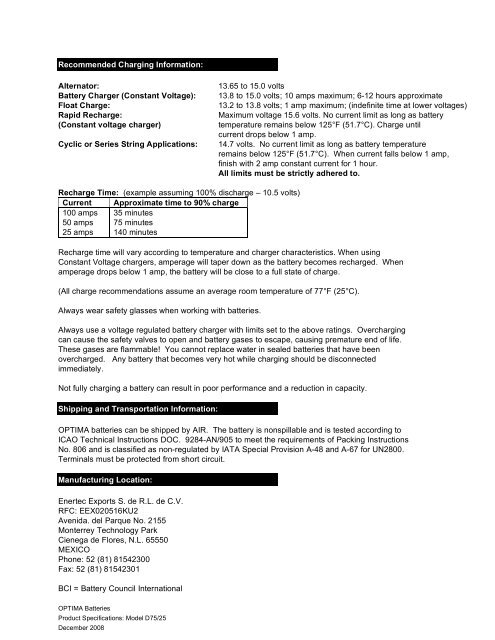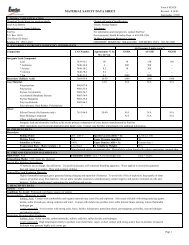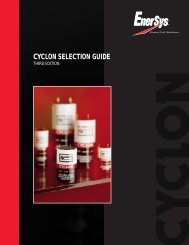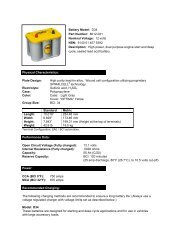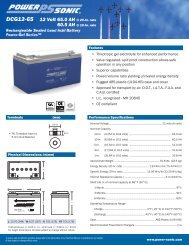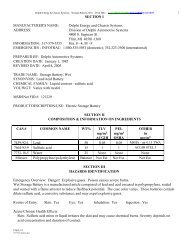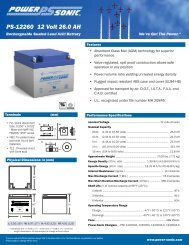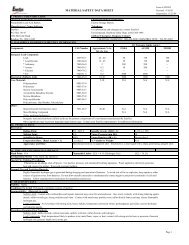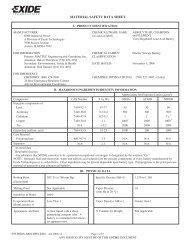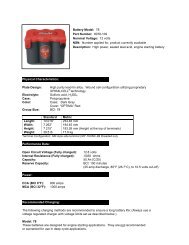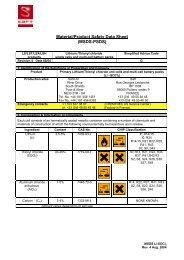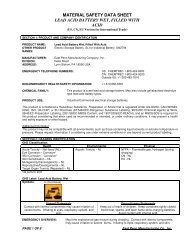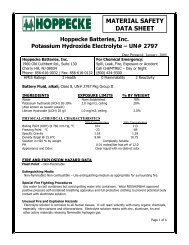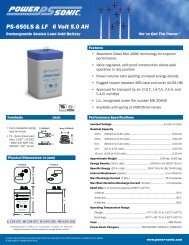Group D75(25) YellowTop - Battery Web
Group D75(25) YellowTop - Battery Web
Group D75(25) YellowTop - Battery Web
You also want an ePaper? Increase the reach of your titles
YUMPU automatically turns print PDFs into web optimized ePapers that Google loves.
Recommended Charging Information:<br />
Alternator:<br />
<strong>Battery</strong> Charger (Constant Voltage):<br />
Float Charge:<br />
Rapid Recharge:<br />
(Constant voltage charger)<br />
Cyclic or Series String Applications:<br />
13.65 to 15.0 volts<br />
13.8 to 15.0 volts; 10 amps maximum; 6-12 hours approximate<br />
13.2 to 13.8 volts; 1 amp maximum; (indefinite time at lower voltages)<br />
Maximum voltage 15.6 volts. No current limit as long as battery<br />
temperature remains below 1<strong>25</strong>°F (51.7°C). Charge until<br />
current drops below 1 amp.<br />
14.7 volts. No current limit as long as battery temperature<br />
remains below 1<strong>25</strong>°F (51.7°C). When current falls below 1 amp,<br />
finish with 2 amp constant current for 1 hour.<br />
All limits must be strictly adhered to.<br />
Recharge Time: (example assuming 100% discharge – 10.5 volts)<br />
Current Approximate time to 90% charge<br />
100 amps 35 minutes<br />
50 amps 75 minutes<br />
<strong>25</strong> amps 140 minutes<br />
Recharge time will vary according to temperature and charger characteristics. When using<br />
Constant Voltage chargers, amperage will taper down as the battery becomes recharged. When<br />
amperage drops below 1 amp, the battery will be close to a full state of charge.<br />
(All charge recommendations assume an average room temperature of 77°F (<strong>25</strong>°C).<br />
Always wear safety glasses when working with batteries.<br />
Always use a voltage regulated battery charger with limits set to the above ratings. Overcharging<br />
can cause the safety valves to open and battery gases to escape, causing premature end of life.<br />
These gases are flammable! You cannot replace water in sealed batteries that have been<br />
overcharged. Any battery that becomes very hot while charging should be disconnected<br />
immediately.<br />
Not fully charging a battery can result in poor performance and a reduction in capacity.<br />
Shipping and Transportation Information:<br />
OPTIMA batteries can be shipped by AIR. The battery is nonspillable and is tested according to<br />
ICAO Technical Instructions DOC. 9284-AN/905 to meet the requirements of Packing Instructions<br />
No. 806 and is classified as non-regulated by IATA Special Provision A-48 and A-67 for UN2800.<br />
Terminals must be protected from short circuit.<br />
Manufacturing Location:<br />
Enertec Exports S. de R.L. de C.V.<br />
RFC: EEX020516KU2<br />
Avenida. del Parque No. 2155<br />
Monterrey Technology Park<br />
Cienega de Flores, N.L. 65550<br />
MEXICO<br />
Phone: 52 (81) 81542300<br />
Fax: 52 (81) 81542301<br />
BCI = <strong>Battery</strong> Council International<br />
OPTIMA Batteries<br />
Product Specifications: Model <strong>D75</strong>/<strong>25</strong><br />
December 2008


